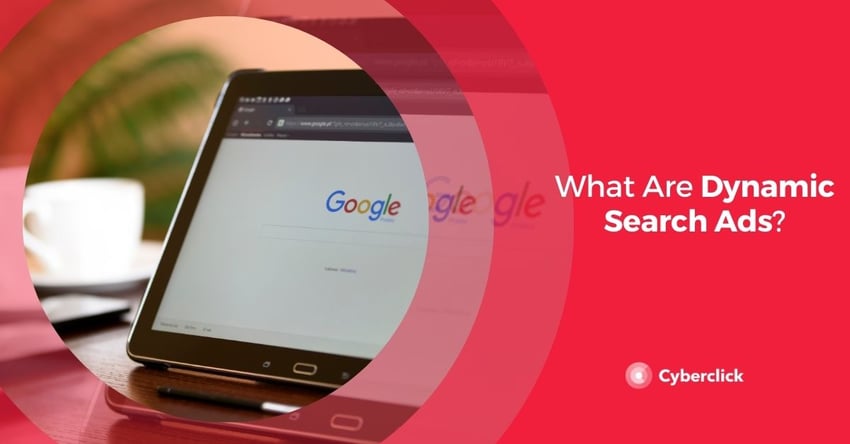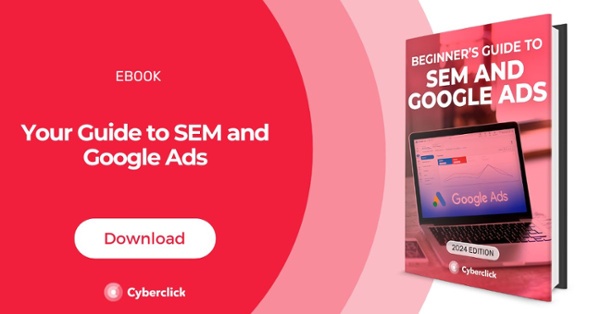Dynamic Search Ads (DSAs) are a powerful way to drive traffic and fill in gaps in your PPC marketing strategy. DSAs help you target your audience better on Google by advertising based on search intent instead of keywords alone. This difference can have a positive impact on your CTR and ultimately your sales. In this mini-guide we’ll cover what Dynamic Search Ads are, how they work, and if they would be a good fit for your business.

What Are Dynamic Search Ads?
Dynamic Search Ads use Google’s crawling technology to scan your website and use that content to create more targeted ads. DSAs are a perfect fit for brands with a large product inventory that Google can index and automatically generate relevant ads for. That being said, DSAs also work well for anyone who can successfully choose and direct ads towards the relevant pages on their website. The important thing is for the page that users land to match with what they’re looking for, which is also dependent on what stage of the buying process they’re in. Google automates this process and serves up your ads in search results to match users queries. So, besides having organic SERPs and keyword targeted ads, DSAs support your search engine marketing (SEM) with intent based advertising.
How Do Dynamic Search Ads Work?
Dynamic Search Ads are generated based on your website content. While traditional Pay Per Click (PPC) Google Ads are created by the advertiser, DSAs are created by Google. This is a way for you to reach potential buyers who you have missed through keyword targeting and also a method of reaching them no matter what stage of the buying process they’re in.
DSAs are dynamic because as information changes on your website so too do your ads—automatically. If, for example, items are out of stock or have changed, your ads will reflect that. Ad headlines are generated by Google and are based on product names, HTML, page titles, etc. As the advertiser, you have control over the ad description but otherwise DSAs are automated by Google.
DSAs work on a Cost Per Click (CPC) basis but instead of bidding on keywords, you bid on the level of ‘auto-target’, meaning which page or pages on your website you want your ads to lead to.
How to Set Up Dynamic Search Ads
Creating a DSA campaign is pretty straight forward. Log into Google Ads and follow these steps.
- Click on the ‘Campaigns’ tab (Make sure it’s for ‘Search Network’ only by unchecking ‘Display Network’)
- Click on ‘Show More Settings’
- Click ‘Dynamic Search Ads’ setting
- Enter your domain and choose your settings
- Select ‘Dynamic’ instead of ‘Standard’ Ad group type to set up your DSAs
- Google recommends creating your Ad Groups based on categories
- Select your auto-targets from the list of URLs on the left (dedicated landing pages work best)
- Select exact URL or set up rules to exclude or include certain text for targeting
- Write a description up to 80 characters and Google will generate the headline
Are Dynamic Search Ads Right for Your Business?
Dynamic Search Ads are an excellent addition to an existing CPC campaign. However, like any advertising campaign, it’s important to plan, strategize, and understand how DSAs work to make the most of your efforts. Here are a few pros and cons to help decide if DSAs are right for your business.
Pro - DSAs Save You Time
You don’t have to plan keywords and create ads. Google does this for you and uses your existing content to create ads that match what people are searching for. You can also reach new leads or markets faster than perhaps you would through other methods.
Con - You Give Up Control of Ads
While allowing Google to automatically generate your ads is great, that does mean that you give up creative control. Sometimes there may be issues. For example, the headline Google generates might not match your description. Because of this, you need to make sure your structure is sound and regularly check your search term reports to see how you’re performing.
Pro - Highly Targeted to Pre Qualified Leads
Dynamic Search Ads work so well because they are targeting people based on their search intent, not just on general interests. This means those users are actively searching for exactly what you’re offering and Google is working as the matchmaker. These are qualified leads who are much more likely to convert than in other types of advertising.
Con - Poor Performing Searches Wasting Budget
This is why your ad structure is so important. If you fail to direct traffic correctly, poor performing search queries can waste your budget before better performing/converting products are searched for. So again, make sure your ad structure makes sense and leads users to what they’re actually looking for!
Pro - DSAs Fill in Advertising Gaps
While keyword targeting is great, you can’t cover all the SEM bases with keywords alone. Dynamic Search Ads allow you to fill gaps in your advertising and reach customers who wouldn’t find you otherwise by crawling your entire website. DSAs can also help you rank for those keywords that are deemed ‘Low Search Volume’ and can’t be displayed in regular Google text ads.
Pro - Improves CTR and Quality Scores
Because DSAs are more based on search intent, CTRs tend to be much higher than with other types of text ads. This higher CTR in turn increases your ad Quality Score which means better ad placement and lower CPC. What DSAs do exceptionally well is increase your CTR with relevant/interested traffic that actually converts and doesn’t just eat up your budget.
Dynamic Display Ads can be a very powerful addition to your SEM campaigns. In terms of scalability and reaching new leads, DSAs are not to be overlooked as an advertising option. Through DSAs, Google helps you connect with new, interested buyers who are searching for exactly what you have to offer. While this saves you time and guesswork, your landing pages still need to have strong CTAs. After all, traffic is great, but conversions are better.
Licenciada en Publicidad y Relaciones Públicas por la UAB. Digital Marketing Strategist en Cyberclick.
Degree in Advertising and Public Relations from the UAB. Digital Marketing Strategist at Cyberclick.






Leave your comment and join the conversation